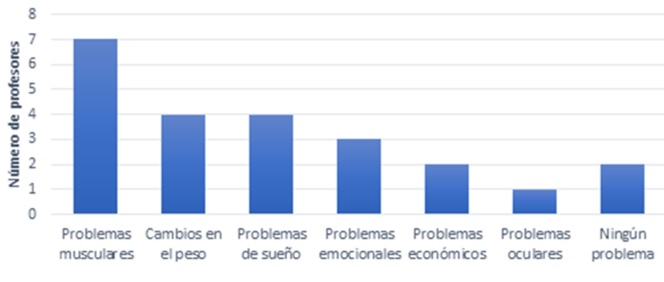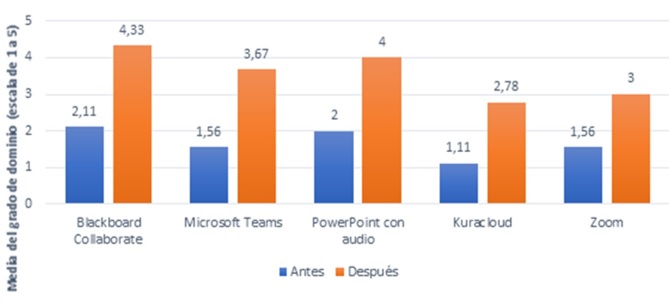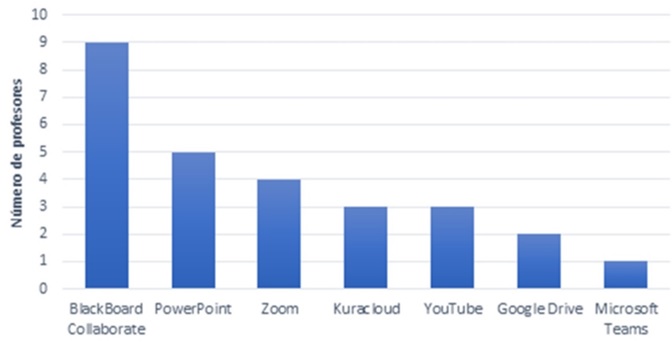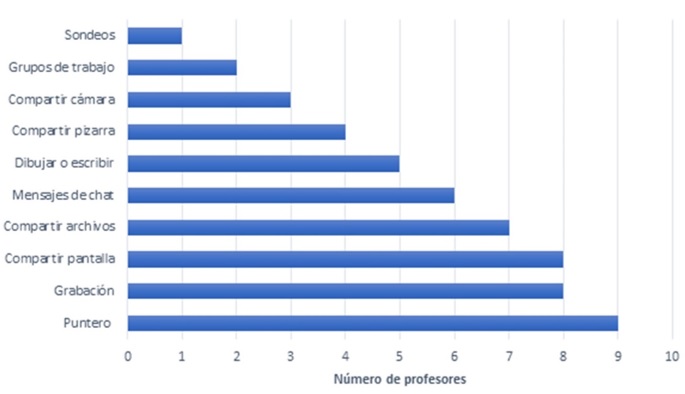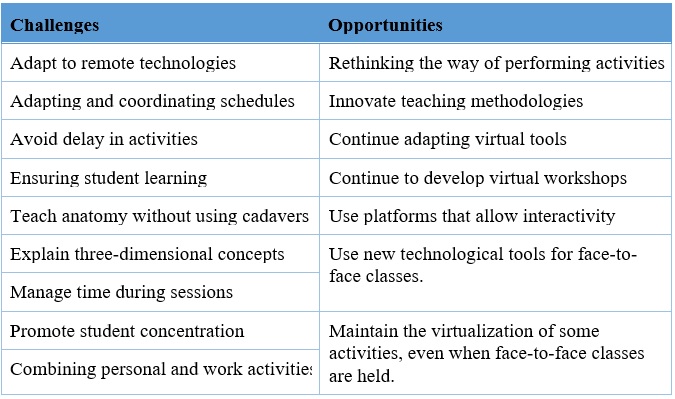Introduction
Historically, the teaching of morphological sciences in different medical schools of the country, has been conducted between teacher and students in a face-to-face manner, with the facility of an effective immediate feedback during lectures, workshops and laboratories. Due to the physical distance and the governmental dispositions for the prevention and mitigation of COVID-19, it was necessary for teachers to adapt to new teaching experiences and to suddenly change to classes in remote modality to achieve the required competencies, without personal interaction (1, 2). Faced with this reality, the teachers, with the support of the different departments of the university, were in charge of devising and implementing solutions for all kinds of unforeseen events, such as connection difficulties and platform limitations, among many other aspects that had to be overcome to ensure an optimal educational process (3).
For more than six months, professors and students around the world have been confronted with abrupt changes to provide continuity in the training of undergraduate and postgraduate medical students (2, 4, 5, 6). However, little is known about the effect of COVID-19 on teaching-learning processes in medical schools, particularly in the teaching of morphological sciences (7). It has been previously evidenced the importance of experiences that allow the student to have a three-dimensional view of the structures, using all senses and activities in different scenarios, for example, anatomical pieces and plastic anatomical models, especially through cadaveric dissections in the amphitheater (7, 8, 9). The observation of histological plates under the microscope allows students to understand the composition of the different tissues that make up the organs that constitute all the systems of the human body (10). Finally, the study of congenital malformations in specimens in the amphitheater gives students a clearer idea of developmental processes and their possible defects (11). In conclusion, adapting these contents to a remote modality (without face-to-face activities) represents an even greater challenge.
To consolidate teaching and learning, the teachers of the Department of Morphological Sciences were unexpectedly forced to implement and integrate different information and communication technologies (TIC), through different electronic and computer devices (1, 3, 12, 13, 14, 15). Although TICs should be support for teacher training, innovating in different academic practices for the planning and development of the different activities, a gradual implementation is required that adjusts to the institutional requirements, since this implies an innovation of the multiple academic practices to achieve enriched learning environments that promote the development of the integral information of students, and to achieve the so-called 21st-century competences, indispensable in a society based on a knowledge economy and the revolution of digital techniques (12, 13, 14, 15).
Given the above, it is necessary to study the impact on teaching activities in the area of human morphology, which required the use of TIC. Anatomy, histology and developmental biology are indispensable areas of knowledge in the training of a health professional, that establish a solid foundation for comprehensive development in professional practice (2, 7). Due to the great impact that the first years of basic training have on medical students, this study aims to establish the perception of Morphological Sciences teachers about the change from face-to-face to remote modality in the context of the 2020 health crisis.
Methodology
To know the perception of the professors of the Department of Morphological Sciences about the change from a face-to-face to a remote modality in the context of the health crisis, a descriptive cross-sectional study was designed by applying a survey to all professors of the Department of Morphological Sciences of the Faculty of Medicine of the Pontificia Universidad Javeriana (Bogota, Colombia).
The survey, which was developed in-house, included variables on the availability of resources, ergonomics of the teachers' work spaces, use and appropriation of technological tools and digital platforms for adaptation to the remote modality, alternative teaching methodologies and communication with students, and workload.
The survey was conducted anonymously and online through a Microsoft Forms® form. To guarantee anonymity, considering that the department has only eleven teachers, the only sociodemographic variable included was sex, since age or time spent teaching could easily allow identification.
The teachers were informed about the purposes of the study, the confidentiality of the information, as well as the voluntary nature of their participation.
Data analysis was performed with the Microsoft Excel® program. Means and standard deviations were calculated for scalar variables and frequencies and proportions for categorical variables. For the open-ended questions, a content analysis was performed using matrices. Inferential statistics were not applied.
Results
Nine of the eleven professors in the department filled out the survey, for a response rate of 81.8%. Women accounted for 55.6% of the respondents.
Availability of resources, work spaces and ergonomics
In terms of available resources, six professors (66.7%) have their own computer for personal use to carry out remote activities and two (22.2%) use a computer provided by the university. All professors use a wireless Internet network, and 88.9% of them consider it to be of good or excellent quality. Most of them (66.7%) have not needed to request technical support from the Directorate of Information Technologies.
Most of the teachers have a home office (66.7%), but there are three who must teach from their bedroom or a common area, such as the living room or dining room. All the teachers surveyed had to purchase devices or services on their own to take on their remote classes: nine purchased a headset or microphone (100%), five purchased a chair (55.6%) and four upgraded their Internet network (44.4%).
Most of the teachers indicate that the noise level around them is the medium (77.8%); only two teachers reported a low noise level. 66.7% of the teachers consider that their work chair is comfortable and that it has an adequate light source. Although most of the teachers (77.8%) take active breaks or changes of activity during their working day, various types of problems are evident from the isolation, most of them muscular (77.8%) (Figure 1).
Use and appropriation of technological tools and digital platforms
Teachers showed a high variation in the time to adapt to the remote modality. On average, it was 6 weeks (SD = 7.533), with a range of 23 weeks. If we remove the two most extreme values (12 and 24 weeks), the average is 2.6 weeks (SD = 1.397), with values between 1 and 4 weeks, which would be more representative of the group of teachers.
On a scale of 1 to 10, the degree of difficulty in adapting to the remote modality was an average of 5.4 (SD = 2.297), with a median and mode of 6, with values between 2 and 9 points.
All the teachers surveyed were familiar with and used basic PowerPoint® for their presentations. Although several teachers were familiar with the audio recording tool (77.8%), none of them recorded their presentations. Most of the teachers were not aware of the Teams® (77.8%), Zoom® (77.8%), KuraCloud® (66.7%) or Blackboard Collaborate Ultra® (55.6%) platforms before the isolation. The others were aware of them, but did not use them.
The degree of mastery of the technological tools increased considerably during the isolation (Figure 2). For Blackboard Collaborate Ultra®, Teams® and PowerPoint® the increase was 2 points or more (on a scale of 1 to 5).
The tool preferred by the teachers for remote activities was Blackboard Collaborate Ultra® (100%), which they all knew and started using during isolation (Figure 3).
Teachers choose tools, taking into account at least two criteria: (i) the potential for synchronous interaction with students, and (ii) the usefulness of the tool. Thus, teachers value tools that allow a dynamic development of classes to interact directly with students, and at the same time are easy to use, practical and versatile.
The Blackboard Collaborate Ultra® tools that teachers always or almost always use in remote activities are: pointer (100%), session recording (88.9%) and application or screen sharing (88.9%). The least used was polling (Figure 4).
The difficulties most reported by teachers during remote activities were the following: students connected but absent when participating (66.7%), connectivity difficulties (55.6%), absent or choppy sound (55.6%) and delay in uploading files (55.6%). However, these difficulties occur only occasionally.
Teaching methodology and communication with students
The teachers changed both their way of planning academic activities (100%) and the methodology of their classes (88.9%). In 55.6% of the cases, the lack of visual contact with the students affected the teacher's concentration and ability to follow a common thread of the subject in class. All of them established a communication channel with the students. The most used was email (66.7%), followed by WhatsApp® (44.4%). Through these channels, mainly academic doubts were resolved (100%); but activities were also coordinated and emotional support was provided.
Most of the teachers used additional material to adapt the anatomy, histology and developmental biology workshops to the remote modality. The most used were images from the Internet (100%) and additional diagrams or explanations (77.8%). Also used were their own images and videos, Internet videos, animations, databases and specialized virtual platforms. 55.6% of the teachers developed these materials themselves (taking photographs or making videos).
The teachers who resorted to a novel method for teaching morphology (55.6%) mentioned the use of virtual platforms in histology to facilitate the handling of the different magnifications of a compound light microscope, the use of atlases of cadaveric images, the making of presentations with screen captures of dissection videos and the execution of their own videos with anatomical models and bone components that would allow a closer view of the three-dimensionality of the structures. Likewise, some professors left homework and evaluated if these were done through activities in the KuraCloud® platform.
For 77.8% of the professors, the time allocated to the classes was insufficient or inadequate to teach the same subject as in the face-to-face modality. This is mainly due to the additional time needed for the explanation of three-dimensional concepts and to the fact that students do not enter the session on time because they are finishing another class. On a scale of 1 to 5, the degree of influence of the additional time used to explain three-dimensional concepts on the time management of the remote classes was, on average 3.8 (SD = 1.481) with a median of 4 and a mode of 5.
During the remote sessions, most teachers do not turn on the camera or rarely do so (44.4%). When they do, they only leave it at the beginning or at specific moments of the session, to let the students identify them, make eye contact with them or to make a gestural explanation. In their own words, teachers use the camera to "have an eye contact with the student, a contact of closeness and accompaniment" or when "I see it necessary to make a particular movement or an explanation that requires the use of hands."
For some teachers, the relationship with students has not changed significantly: "I still maintain a close relationship of trust and respect with the group." However, others mention that it is more impersonal and does not allow for spontaneous encounters outside scheduled activities, for example, in a hallway, the amphitheater or in the office after class.
One of them has gone so far as to feel that "they perceive me as a voice behind a presentation and not as a person." However, some see this situation as an opportunity: "I think it allows us to miss each other and value our academic relationship."
The biggest challenge for the professors during isolation was the use of technological tools for remote realization of academic activities and the virtualization of workshops, particularly in Anatomy: "For now, there is nothing to replace dissection on the cadaver." Similarly, opportunities arise, among which is "the adaptation to a new education system that is here to stay." Table 1 lists all the challenges and opportunities reported.
Generally, the teachers describe the situation as an abrupt change that initially generated anxiety and uncertainty, but which, in the end, was a novel, enriching experience full of learning. However, the teachers expressed concern about several aspects: (i) lack of eye contact, which makes it difficult to evaluate the degree of attention of the students and their attitudes during the class; (ii) the virtuality, which does not allow to easily evaluate the degree of understanding and learning of the students; (iii) the explanations of three-dimensional concepts, which are much more difficult in the remote modality; (iv) not having access to the cadaver, which makes it difficult to learn the depth and three-dimensionality of the structures, and (v) not being able to require students to turn on their camera, the possibility of promoting proper posture and body management when speaking in public is lost.
Workload and emotional aspect of the teacher
The dedication of the teachers to the following activities increased during the isolation: preparation of academic activities (88.9%), domestic activities (88.9%) and care or support of people (77.8%). The working day increased for the nine teachers surveyed; almost half of them (44.4%) stated that their working day, since the change to the remote modality, is much longer.
In general, the teachers felt satisfaction (100%), enthusiasm (77.8%) and peace of mind (66.7%) when teaching remote classes or workshops. Occasionally, some teachers felt frustration (44.4%) and distress (33.3%). The impossibility of interacting face-to-face with students provoked mainly homesickness (55.6%) and sadness (33.3%).
Discussion
All the teachers were faced with an abrupt change in their teaching practice where they had, in the university facilities, computer equipment, almost immediate help from various university agencies and adequate Internet access. Working at home brought with it needs that were not taken into account until they were suddenly forced to adapt their work stations at home. The adaptation of theoretical and practical sessions for remote development was time-consuming, compounded by the performance of other tasks associated with their presence at home.
The change of routines, more time spent sitting in front of the computer, the decrease in physical activity due to confinement and the lack of energy expenditure that occurs when teaching a classroom class, led to health problems such as muscle pain and weight gain, although there was no lack of discomfort typical of confinement, which could have worsened both the adaptation time and its effectiveness (16).
Although there is a dispersion in the data, the average adaptation time does not show a slow process; it was relatively slow if it is related to the fact that the continuity required for the tasks was almost immediate. This shows that it was not an easy change and the learning curve of handling the platforms used and the adaptation of teaching methodologies to the new reality, without losing the interaction with the student, induced the teachers to learn to manage more and better the tools that the platforms provided them, to maintain contact with the students and manage to evaluate the effectiveness of the teaching.
The COVID-19 pandemic generated an abrupt and immediate change and forced the adoption of a remote education model that entailed a sense of vulnerability to the unknown on the part of teachers. One of the biggest challenges was the management of technological tools, which could imply stress and uncertainty in the face of change, especially for teachers with little training in the use of remote education tools (17). Different studies, such as those related to the European Framework of Digital Competence for Educators, conclude that a high degree of digital competence of both teachers and students predicts better learning opportunities for students, as well as a higher degree of interaction and social relationship between teachers and students (18, 19, 20).
The time allotted for developing a topic was another difficulty, which even became a challenge for several reasons. The most important of these was the difficulty in achieving the three-dimensional perspective in the teaching of morphology, which is usually achieved in practical sessions or explanations animated by the teacher (7, 9). Remotely, it required more detailed descriptions or changes in the applications (whiteboard or camera) of the platform that increased class or practice time.
The teachers' perception of the remote modality is ambiguous: they recognize that virtuality prevents them from having adequate interaction (dialog or personal visualization) in the personal sphere, in the classroom and in evaluation; but they consider it as a challenge in the present and for the future.
In spite of all difficulties, teachers feel satisfaction in having achieved the proposed objectives in the best possible way. This finding articulates with the theory of teacher efficacy, promoted especially by Albert Bandura, which expresses that there are more positive results when each individual develops the persistence, enthusiasm, commitment, change and flexibility to transcend teacher self-efficacy, which in turn is dynamic, cyclical and multidimensional (21, 22, 23). This makes teacher self-efficacy and self-confidence significantly increase the probability of success in coping with change and maintaining high student motivation and achievement. Consequently, the higher the teacher's self-efficacy, the lower the teacher's stress, and the higher the teacher's adaptive capacity. This significantly contributes to a faster transition and adaptation to new modalities, while reducing feelings of frustration, distress and uncertainty in both teachers and students. Likewise, self-efficacy and self-confidence, increase with practice, which generates valuable learning and experience for the strengthening of educators' competencies and this has a direct impact on the continuous improvement of the remote teaching process.
The scenario for medical education caused by the COVID-19 pandemic constitutes an unprecedented challenge for education in the country, which forces the adaptation and improvement of new academic scenarios. From this perspective, the professors of the Department of Morphological Sciences of the School of Medicine have not been oblivious to this reality. Despite the uncertainty generated by isolation as an adverse effect, they promoted an adaptive response to the search for and implementation of new ways of teaching, establishing a positive and necessary turn for the training of new health professionals.











 texto em
texto em 


